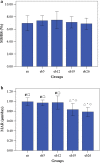Multiscale experimental study on the effects of different weight-bearing levels during moderate treadmill exercise on bone quality in growing female rats
- PMID: 30902108
- PMCID: PMC6431042
- DOI: 10.1186/s12938-019-0654-1
Multiscale experimental study on the effects of different weight-bearing levels during moderate treadmill exercise on bone quality in growing female rats
Abstract
Background: Bone tissue displays a hierarchical organization. Mechanical environments influence bone mass and structure. This study aimed to explore the effects of different mechanical stimuli on growing bone properties at macro-micro-nano scales.
Methods: Sixty five-week-old female Wistar rats were treadmill exercised at moderate intensity with the speed of 12 m/min, and then randomly divided into five groups according to weight-bearing level. After 8 weeks of experiment, femurs were harvested to perform multiscale tests.
Results: Bone formation was significantly increased by weight-bearing exercise, whereas bone resorption was not significantly inhibited. Trabecular and cortical bone mineral densities showed no significant increase by weight-bearing exercise. The microstructure of trabecular bone was significantly improved by 12% weight-bearing exercise. However, similar positive effects were not observed with further increase in weight-bearing levels. The nanomechanical properties of trabecular bone were not significantly changed by weight-bearing exercise. The macrostrength of whole femur and the nanomechanical properties of cortical bone significantly decreased in the 19% and 26% weight-bearing exercise groups.
Conclusion: When rats ran on the treadmill at moderate intensity during growth period, additional 12% weight-bearing level could significantly increase bone formation, improve microstructure of trabecular bone, as well as maintain the structure and mechanical properties of cortical bone. Excessive weight-bearing level caused no positive effects on the trabecular bone microstructure and properties of cortical bone at all scales. In addition, increased weight-bearing level exerted no significant influence on trabecular and cortical bone mineral densities.
Keywords: Bone quality; Moderate intensity; Treadmill exercise; Weight-bearing.
Conflict of interest statement
The authors declare that they have no competing interests.
Figures











References
MeSH terms
Grants and funding
LinkOut - more resources
Full Text Sources
Miscellaneous

